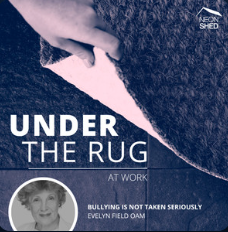Evelyn Field is a psychologist, author, speaker and bullying guru.
Bullying isn’t taken seriously with Evelyn Field OAM
Nicole lifts the rug on why bullying is bad and why it’s not taken seriously at work with @Evelynfield11 OAM. We also chat about why bullying is a brain injury and why we shouldn’t be focused on proving it occurred, instead we should be focused on the harm it causes Evelyn is a psychologist, author, speaker and chair of the Australian Association for Workplace Bullying Professionals. She was awarded an Order of Australia Medal for her initiatives for school and workplace bullying.
Under the Rug at Work Podcast – Bullying is not taken seriously with Evelyn Field OAM
Nicole lifts the rug on why bullying is bad and why it’s not taken seriously at work with Evelyn Field OAM. We also chat about why bullying is a brain injury and why we shouldn’t be focused on proving it occurred, instead we should be focused on the harm it causes. Evelyn is a psychologist, author, speaker and chair of the Australian Association for Workplace Bullying Professionals. She was awarded an Order of Australia Medal for her initiatives for school and workplace bullying. Find out more about Evelyn at www.bullying.com.au
If there’s something that’s swept under the rug in your workplace that you want me to shine light on, let me know on my website www.neonshed.com.au
The You Project Podcast with Craig Harper
This was an interesting chat with someone (Evelyn) who has been working in and around bullying for decades.
Bully Blocking – The Lack of Evidence-based Progress in this Area
In Generation Next’s Podcast, host Andrew Fuller talked with Evelyn E Field OAM, about why do people bully.
Fight or flight: how to beat the bully
Bullies abound. It is a sad fact of working life that you can’t avoid contact with people who shout, intimidate, undermine and dump unreasonable amounts of work on your desk.
But there are incidences tactics you can use to avoid becoming a victim. These may involve making sure that you are not the target, learning how to cope till you get out from under the thumb, or fighting back.
US management professor Robert Sutton expounds the value of developing indifference and emotional detachment. In other words: learning not to give a stuff.
“Passion is an overrated virtue in organisational life, and indifference is an underrated virtue,” he writes in his widely read The No Asshole Rule: Building a Civilised Workplace and Surviving One That Isn’t.
This book (Hachette Book Group USA, is 2007) has become a self-help Bible for the working oppressed.
He continues: “When your job feels like a prolonged personal insult, focus on just going through the motions, on caring as little as possible about the jerks around you, and think about something more pleasant as often as you can – just get through each day until something changes your job or something better comes along.”
Obviously, there will be a flow-on effect to your productivity, but when you are just trying to maintain your around mental health against the onslaught of a bully, worrying about the company bottom line should fall to the people who hire the bullies and allow them to continue their destructive behaviours.
Australian psychologist Evelyn Field, who consults in this area, gives the thumbs-up to this approach but counsels that victims should educate themselves about the tactics that are available to them and then try to select the right one to defeat the efforts of that particular bully.
“You actually have some options, but it is up to you to choose,” she says.
The most obvious thing to do is leave, but this is not always immediately possible for people with families and mortgages to support and careers to nurture.
It may be that the best approach is to have the courageous conversation: tell the person that their behaviour is not acceptable, or ask for a meeting to discuss the problem you are having with their behaviour.
However, if that person is intimidating, you will have to be brave to stand your ground and not everybody life is equipped to stand up for themselves.
You may need a counsellor or career coach to help steel your nerve, she says.
If the bully is one of the psychopaths that walk among us (3 to 4 per cent of the population), this approach may not be successful and Field advises people to get expert advice before tackling them.
Making yourself a small target is another tactic. “Keep your head down, minimise your hours at work, go walking at lunch time, talk to everyone and be friendly, and don’t make any waves,” she says.
Sutton advises to limit contact, avoid meetings, be polite but impersonal, avoid snapping back, and don’t sit down during meetings (it makes them shorter).
Or you can suck up. Field says you could become adept at the saccharine comment: “I’d never be able to do your job. I don’t know how you do it,” or “The feedback from your presentation last week was amazing.”
Again, be friendly and bring lamingtons for everybody, says Field. Another way so to protect yourself is to be seen as well-connected. If you are on familiar terms with the bosses, you are less likely to be targeted.
Field suggests you should use any excuse to be seen shooting the breeze with the “higher ups”, making them laugh and appearing to be sharing confidences.
It depends on the bully (some will target tall poppies, while others prefer to monster the meek), but your posture and dress can also stop you being identified as a potential victim.
Particularly for women, good grooming is a sign you can project that you have good self-esteem.
Field recommends neat hair and earrings and well-manicured nails. “Jangly bracelets also say ‘listen to me’,” she says.
“It is better than projecting that you have nothing to say, there’s nothing to notice, so you can walk over me.”
Group action is a particularly successful tactic. Sutton suggests recruiting other targets and witnesses to provide support and back-up if you decide to take the issue up the line and to human resources. A journal of bullying incidences by a number of people is hard to ignore.
You can also take away their power by not taking them seriously, laugh at their insults, share stories with colleagues and forward the bully’s nasty emails to the group… and their superior.
“If you can’t get reform or expel the bully, find small ways to gain control and to fight back – it will make you feel more powerful and just might convince the bully to leave you and others others alone,” writes Sutton in his blog.
Field says you could make a joke at their expense: “If you are going to yell at me, shall we make an appointment so you can have a really good go in your office?”
One of Field’s clients tells how she learned to deal with the verbal abuse and physical threats from her boss, who is also the owner of the company.
Amanda has been working as a mid-level manager at the firm for five years and for most of that time coped by cowering in a corner and hoping he wouldn’t notice her.
“I was a fall bit like a battered wife,” she says, explaining why she has stayed so long. “I kept and thinking if I just worked harder and worked better, he would stop getting angry at me.”
Being quite stubborn herself, she decided that – although he would clearly like her to resign – she would not be pushed out until she had a good job to go to.
With counselling from Field, she has consciously changed her behaviour towards her boss. She picks her moments and, when there are other people around in an open-plan environment, she will address him with: “Hi, how are you.”
“If he is giving a presentation or talking to the whole organisation, I make eye contact and make a point of holding his gaze. I just feel like I have got a plan and I know I want to get out,” she says.
The first time she tried out the new “emboldened Amanda”, the reaction was electric: “He literally turned around in shock and his eyes said ‘Is she really talking to me?’,” says Amanda.
She is not transforming him, but she is feeling stronger for her job hunt. “You don’t want to go into an interview feeling scared and intimidated,” she says.
Amanda has given some thought to why she was singled out by this man and thinks it may have been because she had to work very closely with him and some people reserve their worst treatment for those who are closest.
“And I have my own issues with self-esteem and maybe he has picked up on that,” she says.
Tellingly, the boss’s behaviour has become part of the culture in the company. People observe it, but don’t stand up for the victims and other bullies cope have emerged over the years.
“We were having a meeting about the HR department – where it should be located on the floor. And the HR manager said it should have frosted glass so people couldn’t be seen when they burst into tears in there,” says Amanda.
“They laughed. They thought it was funny.”
Teachers can be Bullied at Work
Last October, the BBC news highlighted the large compensation payout of over half a million dollars, (AUD) awarded to a former teacher who had been badly bullied. The amount was for personal injury and the damage, from a breakdown, to his health. This teacher had originally been sacked on grounds of gross misconduct. Later it was found that he had been bullied for five years by the former principal of the school. There were no grounds for misconduct, just a vindictive principal. He had support from his union, family and local paper, but not from the governing body of the school or the education authority.
The largest Website on workplace bullying is run by Dr Tim Field (no relation). He said that teachers and lecturers have consistently been the largest group of callers to the UK National Workplace Bullying Advice Line since its inception in January 1996 and inquirers to Bully OnLine at www.bullyonline.org. Teacherline (UK) reports that teachers are four times more likely to experience stress at work than employees in other professions.
The evidence is emerging all over the world that teachers can be bullied by other teachers, senior staff, school council, students and parents. Some schools take pride in their school policy, which deals with student bullying, while concurrently allowing their senior staff and school council to bully teachers. Schools use bullying tactics to get rid of staff. Others use authoritarian attitudes towards naughty students and use this witch-hunt mentality to attack their colleagues. Some foster an attitude of promote the men, while using the women to do the dirty establishment work. Some schools allow parents to threaten and abuse staff while others allow discrimination and exclusion to parents who are different. Some schools disguise bullying and categorise the teacher as stressed.
While most of us were growing up, bullying was regarded as just a part of life. Even the most responsible parents accepted bullying as a school hazard. Today, most parents won’t accept it in any form. Some take legal action. More recently employees, academics and trade union officials are beginning to identify bullying in the workplace, to research and evaluate its impact.
Basically, bullying involves an abuse of power. It can be defined as ‘ all those repeated actions and practices that are directed to one or more workers, which are unwanted by the victim, which may be done deliberately or unconsciously, but cause humiliation, offence and distress, and this may interfere with job performance, and/or cause an unpleasant working environment. (Einarsen 1998) There are many types of bullying behaviours. They range from verbal abuse, blame, humiliation, personal and professional denigration, overt threats, harassment (eg racial, sexual) manipulation of job specifications, aggressive e-mails or notes, professional exclusion, sabotage of career, whistleblower attack, blackmail, criminal assault and murder.
Research reveals that 1 in 6 students are bullied every week in an Australian school. Nothing much seems to change when they grow up and join the workforce, apart from the damage being far greater. According to Paul Mccarthy, Griffith’s University, one in four will experience workplace bullying during their working career. About 10-12% has experienced it in the last 12 months. One in thirty workers is a serial bully. Thus, my current guesstimate based on recent research is that about 15% of people are being regularly bullied in the workplace.
Ultimately, anyone can be a victim or bully. Bullying is caused by many different interacting factors including being in the wrong place at the wrong time. These include the fact that the bully believes that they can get away with it, and generally they can. This includes the loud mouthed, insecure, generally less competent bully, who has poor leadership skills and the sociopathic bully who enjoys seeing people suffer. The fact that the organisational system does not promote equality and condones the abuse of power. The target who may be a quiet achiever, who does not know how to confront the situation effectively or leave.
When a worker becomes sick and tired of constant abuse, seeing their friends and colleagues forced to leave because of a serial bully, some find the courage to investigate union and legal action. Lawyers are on stand-by, well prepared and waiting for those with courage to approach them and use whatever legal opportunities are available to obtain validation or sue for justice. Work cover insurance companies are finding that a bullied teacher, out on stress leaves, is a very costly expense. They will place the cost of higher premiums onto the bullying organisation. Some have successfully sued bullies.
According to the Workplace Bullying Project Team, Griffith’s University, (2001) a recent impact and cost assessment calculated that workplace bullying costs Australian employers billions of dollars a year, when hidden and lost opportunity costs are considered. Since 1996 over 1,000 teachers and principals in the state of Victoria, Australia, have received over $34 million in compensation for stress and injury to health caused mostly by excessive workloads, abuse, lack of support and recognition, and having to deal with difficult students.
Just think about the bullied teacher’s weekly salary, cost of medical and psychological treatment, replacement costs while they are injured, loss of accumulated wisdom built up over many years, the legal costs, the impact on other teachers, such as a terrifying fear that if they do something which is regarded as being a troublesome activity they too will be targeted and lose their job. Teachers go into survival mode not a creative mode. Everyone’s work will slack off. The students will bear the brunt of unmotivated teachers.
According to research by Norway’s Prof. Stale Einarsen, victims of workplace bullying who suffer a post traumatic stress disorder, can take up to 4-5 years to recover. Unfortunately, the stages a workplace victim of bullying experiences and the appropriate treatment has been inadequately researched. Many psychologists, psychiatrists, general practitioners and lawyers do not distinguish adequately between chronic stress and trauma. Thus treating the bullied teacher is also handicapped by the lack of adequate research. Now do your sums to work out what this is costing a school!
Action needs to take place on a number of levels within a school. The first level is to develop a Code of Conduct, which includes appropriate processes and procedures to identify and deal with bullying, and training resources to reduce it. All staff require a preventative and educational program in order that they can recognise what is happening and know where to get help. Employees require appropriate assistance to deal with bullying. Crisis intervention procedures need to be explicit and followed equitably. Investigations and dispute resolution procedures need to be conducted by trained professionals, with respect to the Laws of Natural Justice. Sanctions need to be applied to employees who lack empathy, insight, appropriate relating skills and an inability to listen to clear feedback and change inappropriate behaviours. The bully too needs help in learning more appropriate ways of getting the job done without resorting to mental torture.
Ultimately best school practices means looking after teachers in order that they can achieve the schools aims and objectives and that they feel a valued integral part of the process. It is up to every school to take responsibility for creating a safe and productive working environment for its staff and deal with bullying effectively when it occurs.










